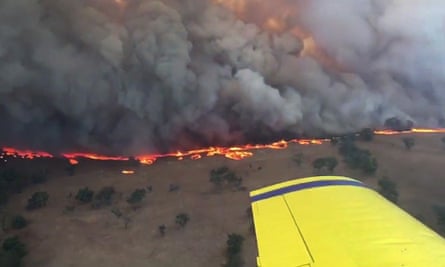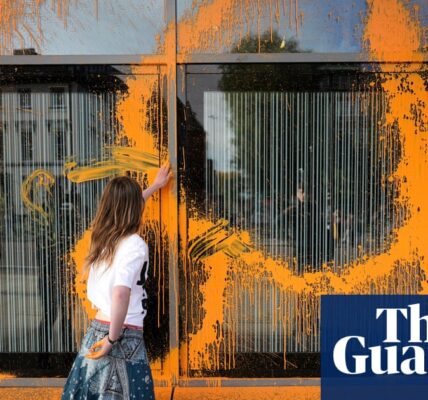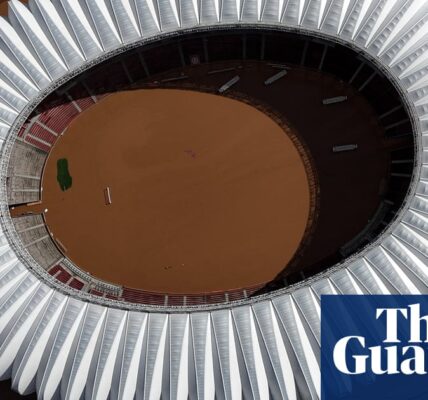Fury road: a forlorn hope that, for once, Australia would choose the hard path on climate | Calla Wahlquist
There is an element of time travel to driving a road you once knew well. The route along the Olympic Highway, which turns off the Hume Freeway just north of Albury and runs through Wagga Wagga to Cowra and then becomes a series of single-lane roads all the way to Cassilis, is etched into the back of my mind.
We drove it once or twice a year to see my grandparents. I remember when the McDonald’s opened at Cowra – an exciting day for my parents, because Cowra was exactly the halfway point of our drive and an ideal spot for lunch. But it was a devastating day for my sister and I, who had previously been able to wrangle two fast food stops (one at Wagga, before 10.30am to get the breakfast menu, and a second at Wellington for a fried afternoon tea).
It has been 10 years. For some towns – The Rock, Henty, Junee – it could still be 1993. Others, like Young, have boomed. But most turns look the same.
The biggest difference is the solar and windfarms. Much of the route is in the Central-West Orana renewable energy zone, and there are renewable energy developments every few hours. I notice them because they weren’t there last time. It’s like seeing an old friend with a moustache. You never like it at first.
It is easy, driving through the development zones, to see why locals are angry. It’s like someone in the city seeing a new block of apartments where a heritage pub once stood; the kind of change that gets a petition circulating.
But – and I’ll be hung, drawn and quartered for this – most areas that I drive through where windfarms have been built were never highly productive. It’s predominantly light country, sheep grazing country. Still is, sheep not being bothered by turbines and, according to some case studies, actually thriving under the shelter of solar panels. In the 90s half the ridges that now host turbines were purple from Paterson’s Curse. The valleys are productive but the ridges were cleared some time before 1950 and lost all their topsoil within a decade. Only rabbits made a living up there.
It’s hard to begrudge a farmer for accepting the minimum fee of $40,000 a turbine a year – it may be the only thing saving the farm.
The trip used to end with a twist of the Golden Highway, when the woolshed would come into view. A few more seconds and you’d see the steep driveway rising out of the cutting. Both the woolshed and the house burned down in 2017, and that half of the driveway is overgrown – my uncle owns the farm now, and he uses the other side. Nowadays we drive on and turn right a few kilometres down the road to where the Uarbry church and memorial hall used to stand. Our family pew was the first on the right and we were under strict orders from grandma to grab it should they ever decommission.
Those buildings are also gone now, lost in the same bushfire. In their place is a roof-only shed, which provides shade for funerals. Down a rutted lane, through the stickiest yellow mud, are my grandparents and many of their siblings, in the overgrown paddock of the Uarbry cemetery. And I’m glad, every time, that they weren’t here to see the fire.
There were fires before the climate began heating in earnest, of course. We grew up on stories of uncles losing all the hair on their arms as someone floored it through the flames. But fires like the Sir Ivan blaze, a towering pyrocumulonimbus that burned through 55,000 hectares in two days and destroyed 35 homes, are becoming more common. And we know it’s because of the climate emergency.
That’s a fact. It won’t change, no matter how hard you ignore it.

There’s a plan to build a big windfarm in the area, marching down towards Uarbry, with an associated high-voltage transmission line. Most of my family, including all who still live in the area, are against it.
I understand that opposition. But I’ve never thought, I’m glad my grandparents aren’t here to see the windfarm. They may hate it, just as they hated the ever-expanding Ulan coalmine, or they may see it as a defence against the latter. They’d curse the Labor government into oblivion and keep voting National, as everyone in the area always has. But it wouldn’t have a prolonged negative effect on their lives. It wouldn’t destroy their home. It would increase traffic, and inconvenience them, and sap up the remaining local workforce and make it even harder to find good workers. That’s not nothing. That is nothing weighed against the challenge of keeping global heating below 1.5C – a target increasingly out of reach, but one which we can’t lose sight of.
In 2019, during the bushfires, I interviewed a father who had built an off-grid home on the New South Wales south coast and was speaking to me from its ashes. He told me he was angry. Furious, he said, at the decades wasted in the climate wars. Furious that for the sake of short-term political gain, the life he’d always wanted – not a glamorous life, a small life in a mudbrick cottage – was no longer available. Furious that because of global heating, bushfires in that region had gone from risk to certainty.
Listening to Peter Dutton announce his nuclear policy, I felt that fury. We’re doing this again. As if we didn’t lose 33 lives and hundreds of houses to fire in 2019-20 and then even more houses, even more lives, to floods in the following two years. As if we hadn’t seen the reef dying and the Darling River dying and farms going under in drought. As if the evidence wasn’t in a thousand times over. As if we weren’t, through decades of inaction, possibly already too late.
We’re going to have this stupid bloody fight again.
I had hoped, by now, we could move past the first page of the climate debate, the one where half the participants aren’t really convinced it was happening. I had hoped we could start having nuanced and difficult conversations about the transition to renewables – because it has been flawed in many parts, and the community consultation has been lacking, and some of the locations chosen are not appropriate. There are thorny issues to unpick here, and the binary division of a climate war is more comfortable ground.
But I had hoped that, for once, Australia would choose the hard path.
-
Sign up for the Rural Network email newsletter
-
Join the Rural Network group on Facebook to be part of the community
Source: theguardian.com


